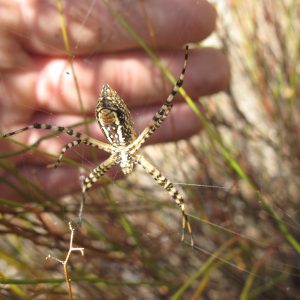This is my final month in New Mexico. Next week my brother flies out to endure the 24 hour drive home with me. He’ll be the first and last visitor at my mountain home and there is so much of the Land of Enchantment that I want to show him before we head off. Everybody who I’ve interacted with during the past 6 months has made a lasting impact on me: My mentor is one of the most patient and educated bosses that I’ve ever had, the group of friends I have developed at the office are amazing, and leaving my amazing “mountain family” (the two host families and some of the volunteers at the recreation center) will be hard to do.

The Organ Mountains, where I've called home for the past 6 months, woke up in the clouds.
December made sure its presence was noticed. A week ago, my part of New Mexico experienced more snow and chilly temperatures then my family in the Midwest experienced. After receiving a brief flurry, our office (as well as Roswell and Carlsbad) was released an hour early and granted a snow day. Although I was anticipating a snow-free winter, the powdered mountaintops offered a much more enjoyable experience as opposed to the ugly black slush and knee-high snow that the Chicago area is accustomed to. Plus everything melted by the weekend and temperatures were back to the mid-50’s.

Snowfall at Dripping Springs Nature Center
Now to reminisce about the past half year…
My first week as a CLM intern began in June at the workshop held in Chicago. I hadn’t even been to Las Cruces and I had absolutely no clue what to expect out of this internship. I met my co-intern, whom I would be living and working with. I was also able to get introduced with the Seeds of Success program and the process involved in seed collection. The following week I made my first ever solo trip out west. At the end of July we made our first full-fledged, team SOS collection of Helenium microcephalum var. microcephalum in an overgrazed, cow-dung infested field. By the end of August and September we had completed eleven collections which we considered a success. The harsh winter freeze from the previous year mixed with the hot, dry summers resulted in few native plants going to seed. We spent weeks working on a population density survey for Escobaria duncanii which was undeniably my favorite project. Our team drove all over southern New Mexico looking for plants to collect and learning all about the different habitats. Our last project as a full team was collection of leaf samples from Lepidospartum burgessii in the salt flats near Guadalupe Mountain. In November, our team was down to two members: my mentor and I spent three days in Roswell retrieving updated plant statuses for the potted Culp Sand Bluestem project that began three years ago (The bluestem is a key element in the habitat for both the Lesser Prairie Chicken and the sand dune lizard). This month I helped my mentor set up a new survey area in the Franklin Mountains to observe the density of a population of Escobaria sneedii. It was a great project that allowed me to stay busy on office days but still got me out in the field quite often.

A fall scene from the top of Caballo Mountain near Truth or Consequences, NM
I’ve learned just as much in my free time as I have during my work days. Hiked along the Gila River and discovered that substantial sandals are great investments when the trail you follow crosses the water more than ten times. Watched my roommate discover the best way to collect, de-spine, and separate seeds from prickly pears to make jelly. Found out that it’s best to call ahead to forest campgrounds in the middle of hot, dry summers to see if they’re open or not before driving two hours to the site to find out that it’s closed due to extreme fire hazards. Discovered the best way to catch and remove tarantulas, scorpions and lizards from the bunkhouse and got stung by a scorpion (just last week, look out!). I learned that it is best to bring a flashlight when going to a nighttime tour of zoos. I finish a half marathon and an obstacle 5K race. I experienced the fantastic culture that surrounds the southwest and walked with the community in the Dia de los Muertos procession. And most importantly, I perfected my own version of green chili stew.

I found a cow-bone-cholla-shrine while hiking a trail around the Organs, decided it was a good point to turn back.
It’s amazing how much of what I have learned over a year and a half ago during college is actually being put to use in multiple aspects of this internship and I’m so inexplicably thankful to the cast at the Chicago Botanic Garden and my mentor for the opportunity to experience and explore New Mexico for the past 6 months. The countdown is on and I have less than 10 days before I leave my mountain home and one thing for sure is that it won’t be too long before I return! ¡Adios Nuevo Mexico!












